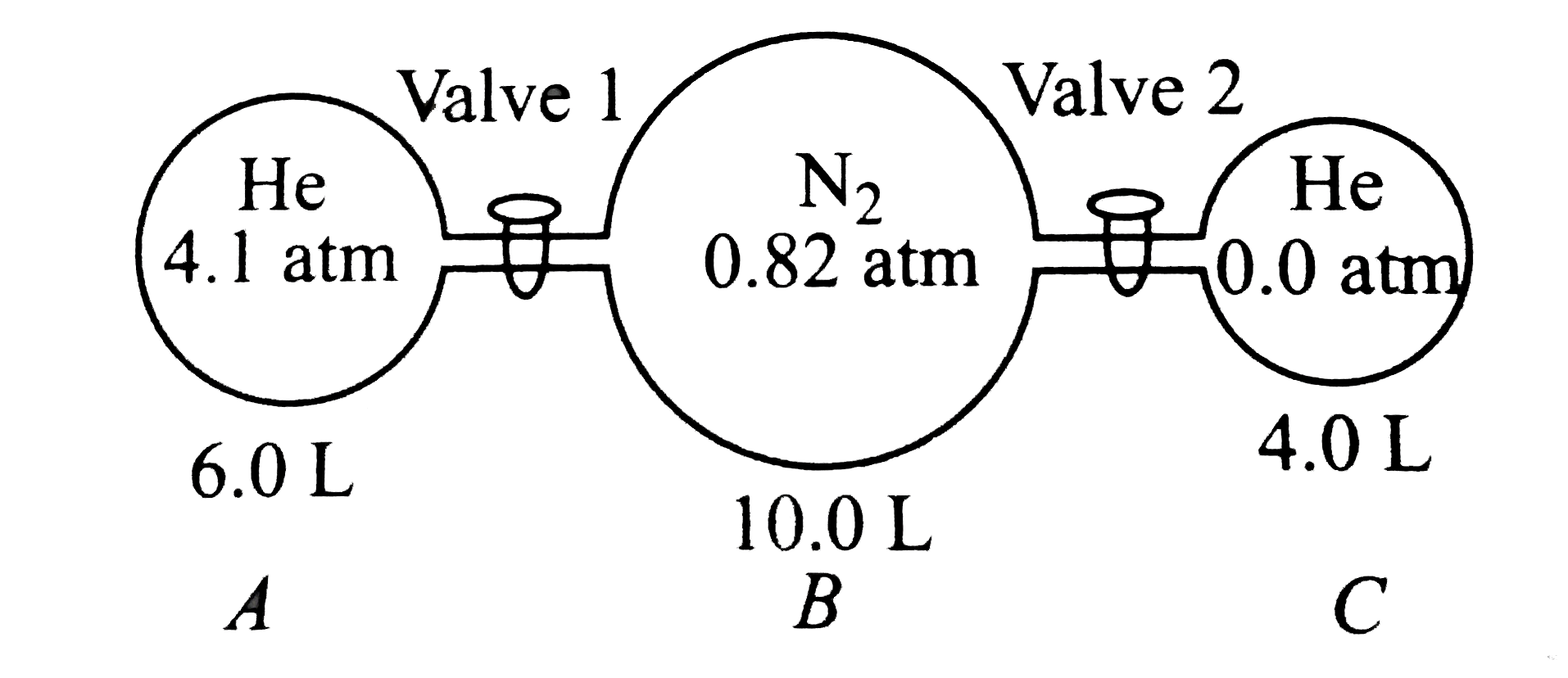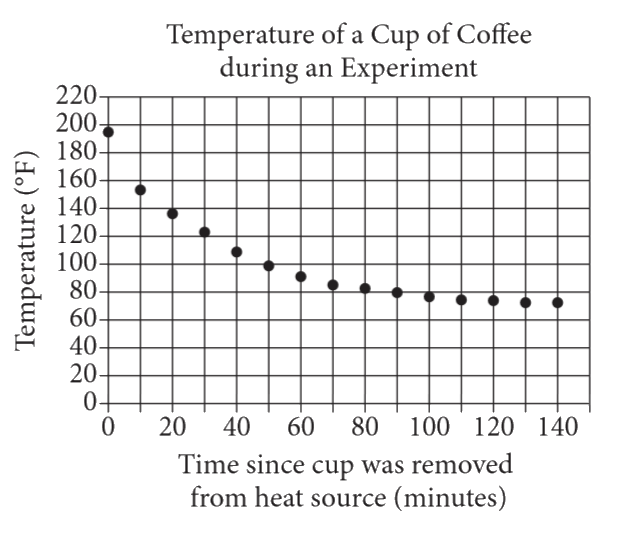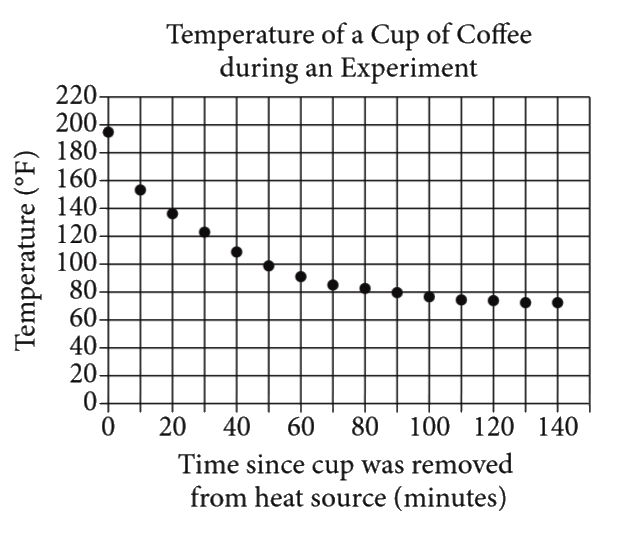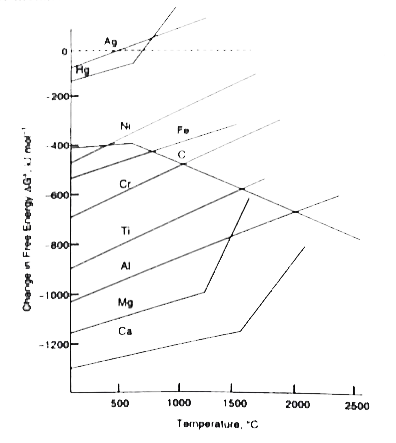In an experiment, the temperature of the reactants was being carefully monitored. It was observed that the maximum and minimum temperature recorded were 64.7∘Fahrenheit and 72.05∘ Fahrenhit . Which of the following inequalities represents all possible temperature values, t, observed during the experiment ?
|t−72.05|>7.35
|t−72.05|=7.35
|t−72.05|≤7.35
|t−72.05|<7.35
The correct Answer is:C
To solve the problem, we need to determine the inequality that represents all possible temperature values t observed during the experiment, given the minimum and maximum temperatures recorded.
1. Identify the Minimum and Maximum Temperatures:
- The minimum temperature recorded is 64.7∘F.
- The maximum temperature recorded is 72.05∘F.
2. Set Up the Inequality:
- We want to express that the temperature t can take any value between the minimum and maximum temperatures, inclusive.
- This means t can be greater than or equal to the minimum temperature and less than or equal to the maximum temperature.
3. Write the Inequality:
- The inequality that represents this situation is:
64.7≤t≤72.05
4. Interpret the Inequality:
- This inequality indicates that the temperature t can be any value starting from 64.7∘F up to 72.05∘F, including both endpoints.
5. Check for Correctness:
- The inequality includes both the minimum and maximum temperatures, which is consistent with the problem statement that both temperatures are recorded.
Final Answer:
The inequality that represents all possible temperature values t observed during the experiment is:
64.7≤t≤72.05
- The minimum temperature recorded is 64.7∘F.
- The maximum temperature recorded is 72.05∘F.
- We want to express that the temperature t can take any value between the minimum and maximum temperatures, inclusive.
- This means t can be greater than or equal to the minimum temperature and less than or equal to the maximum temperature.
- The inequality that represents this situation is:
64.7≤t≤72.05
- This inequality indicates that the temperature t can be any value starting from 64.7∘F up to 72.05∘F, including both endpoints.
- The inequality includes both the minimum and maximum temperatures, which is consistent with the problem statement that both temperatures are recorded.
The inequality that represents all possible temperature values t observed during the experiment is:
64.7≤t≤72.05
Similar Questions
The figure given below shows three glass chambers that are connected by valves of negligible volume. At the outset of an experiment, the valves are closed and the chambers contain the gases as detailed in the diagram. All the chambers are at the temperature of 300K and external pressure of 1.0atm.

Which of the following represents the total kinetic energy of all the gas molecules after both valves are opened?
(R=0.082atmLK−1mol−1=8.314JK_1mol−1)
View Solution
In an experiment, a heated cup of coffee is removed from a heat source, and the cup of coffee is then left in a room that is kept at a constant temperature. The graph above shows the temperature, in degrees Fahrenheit (.∘F), of the coffee immediately after being removed from the heat source and at 10-minute intervals thereafter.
Of the following, which best approximates the temperature, in degrees Fahrenheit, of the coffee when it is first removed from the heat source?
View Solution
In an experiment, a heated cup of coffee is removed from a heat source, and the cup of coffee is then left in a room that is kept at a constant temperature. The graph above shows the temperature, in degrees Fahrenheit (.∘F), of the coffee immediately after being removed from the heat source and at 10-minute intervals thereafter.
During which of the following 10-minute intervals does the temperature of the coffee decrease at the greatest average rate?
View SolutionAn experiment is being performed by a student in laboratory on ideal gas. He found the value of CP−CV equal to 1.00 R in state A and is 1.08 R in state B.. Let P_A, P_B denote the pressures and T_A, T_B denote the temperature of state A and B respectively. Which of the following will be correct?
View SolutionA chemist studied the phenomenon of adsorption by putting blood charcoal in KCL solution. He observed difference in the behaviour with dilute KCL solution and with concentrated KCL solution. He also studied the adsorption of different gases on solid adsorbent and the effect of temperature on adsorption. He put forward a mathematical relationship relating x/m with equilibrium pressure.
Which of the following result is oberved with the experiment of KCl solution ?
View SolutionFor a sponaneous reaction, the free energy change must be negative, ΔG=ΔH−TΔS,ΔH is the enthalpy change during the reaction. T is the absolute temperature, and ΔS is the change in entropy during the reaction. Consider a reaction such as the formation of an oxide
M+O2→MO
Dioxygen is used up in the course of this reaction. Gases have a more random structure (less ordered) than liquid or solids. Consequently gases have a higher entropy than liquids and solids. In this reaction S (entropy or randomness) decreases, hence ΔS is negative. Thus, if the temperature is raised then TΔS becomes more negative,Since, TΔS is substracted in the equation, then ΔG becomes less negative. Thus, the free energy change increases with the increase in temperature.
The free energy changes that occur when one mole of common reactant (in this case dioxygen) is used may be plotted graphically aginst temperature for a number of reactions of metals to their oxides. The following plot is called an Ellingham diagram for metal oxide. Understanding of Ellingham diagram is extremely important for the efficient extraction of metals.

For the conversion of Ca(s) to Ca(s) which of the following represent the ΔG vs. T ?
View SolutionAs part of his discovery of the neutron in 1932, James Chadwick determined the mass of the neutron (newly identified particle) by firing a beam of fast meutrons, all having the same speed, as two different targets and measuing the maximum recoil speeds of the target nuclei. The maximum speed arise when an elastic head-on collision occurs between a neutron and a stationary target nucleus. Represent the masses and final speeds of the two target nuclei as m1,v1,m2 and v2 and assume Newtonian mechanics applies. The neutron mass can be calculated from the equation:
mn=m1v1−m2v2v2−v1
Chadwick directed a beam of neutrons on paraffin, which contains hydrogen. The maximum speed of the protons ejected was found to be 3.3×107m/s. A second experiment was performed using neutrons from the same source and nitrogen nuclei as the target. The maximum recoil speed of the nitrogen nuclei was found to be 4.7×106m/s. The masses of a proton and a nitrogen nucleus were taken as 1u and 14u, respectively. What was Chadwick's value for the neutron mass?
View SolutionIn an experiment for determining the value of acceleration due to gravity (g) using a simpe pendulum , the following observations were recorded:
Length of the string (l)=98.0cm
Diameter of the bob (d)=2.56cm
Time for 10oscillations(T)=20.0s
Calculate the value of g with maximum permissible absolute error and the percentage relative error.
View SolutionA set of 6 test tube having same temperature but different pH were setup to conduct an experiment . To each of the tubes, starch and amylase were added in a mix of sterile water . The concentration was kept the same . The following table notes the reaction completion time for each of the six tubes.
PH1357911Time taken to complete in seconds (s).94643253566
Using the above data , determine the pH where amylase has shown highest rate of activity.
View SolutionCollision is a physical process in which two or more objects, either particle masses or rigid bodies, experience very high force of interaction for a very small duration. It is not essential for the objects to physically touch each other for collision to occur. Irrespective of the nature of interactive force and the nature of colliding bodies, Newton's second law holds good on the system. Hence, momentum of the system before and after the collision remains conserved if no appreciable external force acts on the system during collision.
The amount of energy loss during collision, if at all, is indeed dependent on the nature of colliding objects. The energy loss is observed to be maximum when objects stick together after collision. The terminology is to define collision as 'elastic' if no energy loss takes place and to define collision as 'plastic' for maximum energy loss. The behaviour of system after collision depends on the position of colliding objects as well. A unidirectional motion of colliding objects before collision can turn into two dimensional after collision if the line joining the centre of mass of the two colliding objects is not parallel to the direction of velocity of each particle before collision. Such type of collision is referred to as oblique collision which may be either two or three dimensional.
For which of the following collisions, the external force acting on the system during collision is not appreciable as mentioned in paragraph 1.
View Solution
